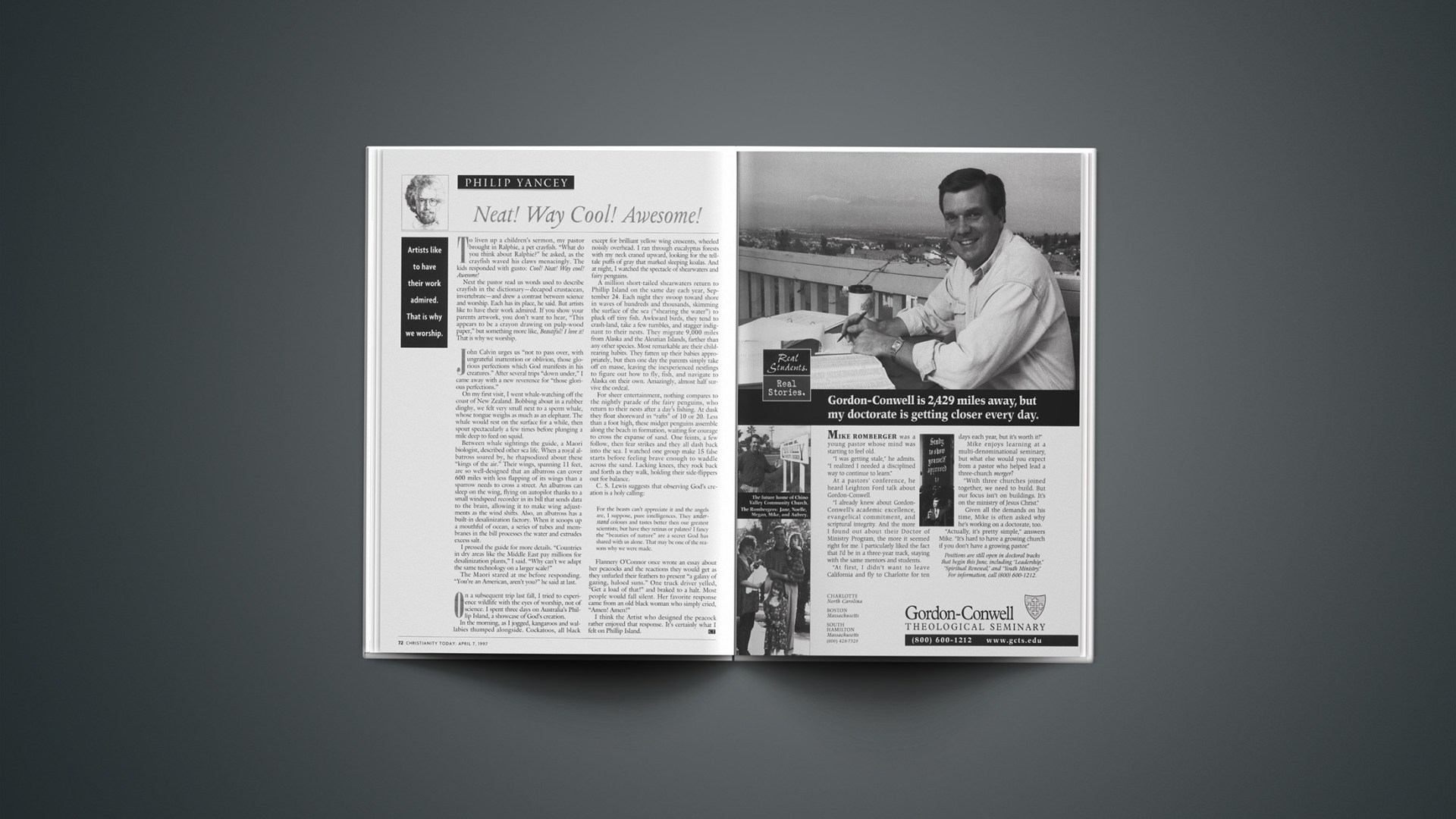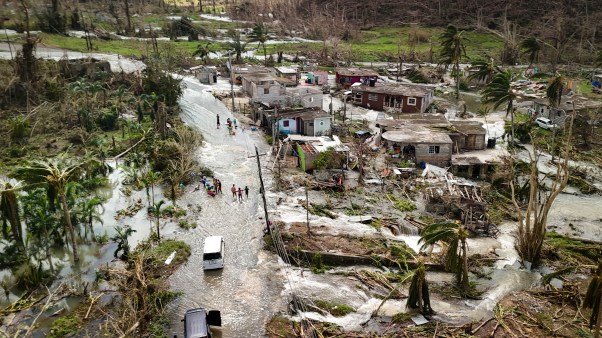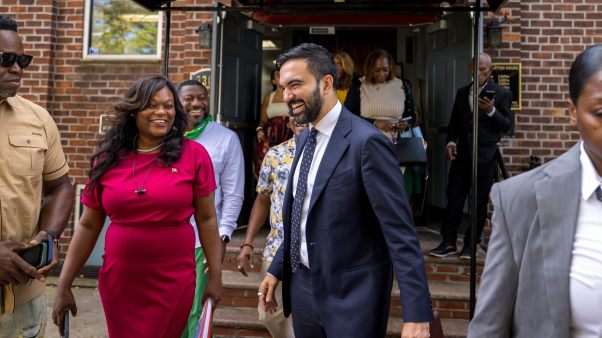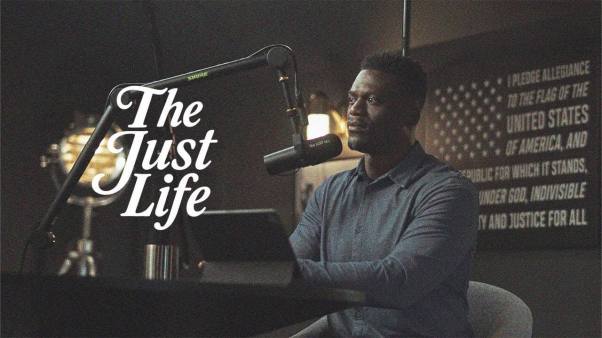To liven up a children’s sermon, my pastor brought in Ralphie, a pet crayfish. “What do you think about Ralphie?” he asked, as the crayfish waved his claws menacingly. The kids responded with gusto: Cool! Neat! Way cool! Awesome!
Next the pastor read us words used to describe crayfish in the dictionary—decapod crustacean, invertebrate—and drew a contrast between science and worship. Each has its place, he said. But artists like to have their work admired. If you show your parents artwork, you don’t want to hear, “This appears to be a crayon drawing on pulp-wood paper,” but something more like, Beautiful! I love it! That is why we worship.
John Calvin urges us “not to pass over, with ungrateful inattention or oblivion, those glorious perfections which God manifests in his creatures.” After several trips “down under,” I came away with a new reverence for “those glorious perfections.”
On my first visit, I went whale-watching off the coast of New Zealand. Bobbing about in a rubber dinghy, we felt very small next to a sperm whale, whose tongue weighs as much as an elephant. The whale would rest on the surface for a while, then spout spectacularly a few times before plunging a mile deep to feed on squid.
Between whale sightings the guide, a Maori biologist, described other sea life. When a royal albatross soared by, he rhapsodized about these “kings of the air.” Their wings, spanning 11 feet, are so well-designed that an albatross can cover 600 miles with less flapping of its wings than a sparrow needs to cross a street. An albatross can sleep on the wing, flying on autopilot thanks to a small windspeed recorder in its bill that sends data to the brain, allowing it to make wing adjustments as the wind shifts. Also, an albatross has a built-in desalinization factory. When it scoops up a mouthful of ocean, a series of tubes and membranes in the bill processes the water and extrudes excess salt.
I pressed the guide for more details. “Countries in dry areas like the Middle East pay millions for desalinization plants,” I said. “Why can’t we adapt the same technology on a larger scale?”
The Maori stared at me before responding. “You’re an American, aren’t you?” he said at last.
On a subsequent trip last fall, I tried to experience wildlife with the eyes of worship, not of science. I spent three days on Australia’s Phillip Island, a showcase of God’s creation.
In the morning, as I jogged, kangaroos and wallabies thumped alongside. Cockatoos, all black except for brilliant yellow wing crescents, wheeled noisily overhead. I ran through eucalyptus forests with my neck craned upward, looking for the telltale puffs of gray that marked sleeping koalas. And at night, I watched the spectacle of shearwaters and fairy penguins.
A million short-tailed shearwaters return to Phillip Island on the same day each year, September 24. Each night they swoop toward shore in waves of hundreds and thousands, skimming the surface of the sea (“shearing the water”) to pluck off tiny fish. Awkward birds, they tend to crash-land, take a few tumbles, and stagger indignant to their nests. They migrate 9,000 miles from Alaska and the Aleutian Islands, farther than any other species. Most remarkable are their child-rearing habits. They fatten up their babies appropriately, but then one day the parents simply take off en masse, leaving the inexperienced nestlings to figure out how to fly, fish, and navigate to Alaska on their own. Amazingly, almost half survive the ordeal.
For sheer entertainment, nothing compares to the nightly parade of the fairy penguins, who return to their nests after a day’s fishing. At dusk they float shoreward in “rafts” of 10 or 20. Less than a foot high, these midget penguins assemble along the beach in formation, waiting for courage to cross the expanse of sand. One feints, a few follow, then fear strikes and they all dash back into the sea. I watched one group make 15 false starts before feeling brave enough to waddle across the sand. Lacking knees, they rock back and forth as they walk, holding their side-flippers out for balance.
C. S. Lewis suggests that observing God’s creation is a holy calling:
For the beasts can’t appreciate it and the angels are, I suppose, pure intelligences. They understand colours and tastes better then our greatest scientists; but have they retinas or palates? I fancy the “beauties of nature” are a secret God has shared with us alone. That may be one of the reasons why we were made.
Flannery O’Connor once wrote an essay about her peacocks and the reactions they would get as they unfurled their feathers to present “a galaxy of gazing, haloed suns.” One truck driver yelled, “Get a load of that!” and braked to a halt. Most people would fall silent. Her favorite response came from an old black woman who simply cried, “Amen! Amen!”
I think the Artist who designed the peacock rather enjoyed that response. It’s certainly what I felt on Phillip Island.
Copyright © 1997 Christianity Today. Click for reprint information.









